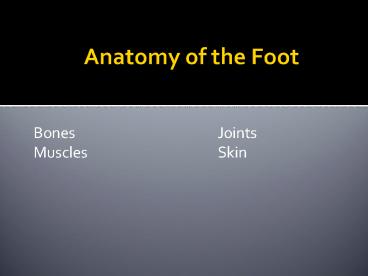Anatomy of the Foot - PowerPoint PPT Presentation
1 / 23
Title:
Anatomy of the Foot
Description:
The ankle joint is composed of the fibula, tibia and talus. A hinge joint that allows the foot to pull up (dorsiflex) and move downward (plantarflex). – PowerPoint PPT presentation
Number of Views:602
Avg rating:3.0/5.0
Title: Anatomy of the Foot
1
Anatomy of the Foot
- Bones Joints
- Muscles Skin
2
Bones of the Foot
- Basic Facts
- There are 26 bones in each human foot. Makes up
one quarter of the entire (208 bones) human body. - 2 in the hind foot or rear foot
- 5 in the midfoot
- 19 in the forefoot
- 2 ancillary bones underneath the first metatarsal
head.
3
Medial View of Foot
Midfoot Navicular, cuneiforms (3) and cuboid
Rear foot/Hind foot Talus and calcaneus
Forefoot Metatarsals (5) and phalanges (14)
4
Lateral View of the foot
Midfoot
Hind foot/Rear foot
Forefoot
5
Dorsal view
The 5 metatarsal bones are made up of three main
partsthe base, the shaft and the head. The base
is at the proximal end. The shaft is in the
middle. The heads are located at the distal ends
of the bones. The heads are the weight bearing
portion of the foot. The metatarsals are numbered
1-5 beginning with the great toe, or hallux.
6
Sesamoids
Located on the plantar side of the great toe
(hallux). Identified by the location on the
foot-- tibial (medial) and fibular (lateral)
sesamoids. Flexor hallucis longus tendon runs
between them. The tendon is responsible for
abducting and adducting great toe.
7
Ankle Bones
- Posterior view of ankle
- Tibia
- Medial malleolus (tibia)
- Lateral malleolus (fibula)
- Talus (slightly displaced)
- Calcaneus
5
8
Circulatory System
- There are three types of blood vessels
- Arteries-carries blood away from the heart
- Veins-transfers blood back to the heart from the
capillaries - Capillaries-connect arteries to veins
9
Posterior Tibial Artery
The posterior tibial artery is found on the
medial side of the ankle and can be palpated.
10
Dorsalis Pedis Artery
The dorsalis pedis artery can be palpated on the
dorsum of the foot between the first and second
ray.
11
Skin
The human skin is the bodies largest organ and
made up of multiple layers. The top layer of
skin, called the epidermis, plays a very
important role in protecting the body against the
environment. Other functions include insulation,
temperature regulation and sensation.
12
Skin
Skin is divided into 3 main layers Epidermis-oute
rmost layer visible Dermis-layer underneath
epidermis Hypodermis- also called the
subcutaneous tissue, used for fat storage. The
thickness of the skin at the soles (and palms) is
1.5 mm at the epidermis layer.
13
Joints
- A joint is the area where two or more bones are
attached for the purpose of motion of human body
parts. - A joint is usually formed of fibrous connective
tissue and cartilage. - There are 33 joints in the human foot.
- They allow the foot to move in many directions
and adapt to many surfaces. - The joints are shock absorbers.
14
Joints
- The metarso-phalangeal joint (MTP) is between the
metatarsals and the phalanges (toes). - Hinge joints that allow mostly plantar and
dorsiflexion and also allow the toes to maintain
contact with the ground during push off.
15
Joints
- The proximal interphalangeal joint (PIP) is
between the proximal and middle phalanges. - The distal interphalangeal joint (DIP) is found
only on phalanges 2-5.
16
Joints
- The ankle joint is composed of the fibula, tibia
and talus. - A hinge joint that allows the foot to pull up
(dorsiflex) and move downward (plantarflex).
Posterior view
Anterior view
17
Joints
- The transverse tarsal joint is comprised of two
jointsthe talonavicular and calcaneocuboid (TNCC
joint). - Also known as the midtarsal or choparts joint
18
Joints
- The tarsometatarsal joint is made up of the
tarsals and metatarsals. - Also known as the Lisfranc Joint.
19
Joints
- The subtalar joint is between the talus and
calcaneus. - Also known as the talocalcaneal joint.
- Acts as a screw-shaped joint and is the primary
joint that allows the foot to turn in (inversion)
or turn outward (eversion)
Posterior view
20
Bursae
Bursae, or singular bursa, fluid filled sacs
commonly located just proximal to insertion of
tendon into bone reduce friction that would
otherwise occur as tendon moves against bone
21
Muscles and Tendons
- Muscles are attached to tendons which insert to
the bones of the foot and toes. - Most muscles that move the foot originate from
the calf (posterior) or shin (anterior) area. - Tendons are a band of fibrous tissue that attach
muscles to the bones. - When a muscle contracts, it pulls on the tendon.
- One of the most prominent tendons is the Achilles
tendon, which can be felt on the back of the
foot, just above the heel. - Tendons can be torn or ruptured and inflammation
is the most prevalent.
22
Muscles
- The gastrocenimus and soleus muscle combine to
form the Achilles tendon. - This allows the ankle and foot to push down
(plantar flex).
23
Achilles tendon
- Most important tendon for walking, running and
jumping. - Attached the calf muscle to the calcaneus.
- Allows us to plantar flex.
- The strongest and thickest tendon.































